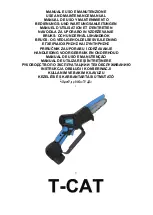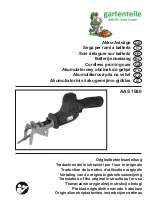
- 6 -
STARTING AND STOPPING
1. Connect the unit to a power supply of the correct
voltage and frequency (120V-60HZ).
2. To start the saw press the switch to the
“I” position (Fig 3).
3. To stop the saw, press the switch to the “O”
position (Fig 3).
WARNING: For your own safety, always position the switch to
the “O” position when the saw is not in use. In the event of a
power failure, blown fuse or tripped circuit breaker, press
switch to the “O” position. This will prevent the tool from
starting up again when the power comes back on.
ASSEMBLY
Read the manual carefully before assembly.
1. Clean the working area.
2. Remove saw from carton, you will find
it assembled.
3. Lay the saw on its side on the ground (Fig 4).
4. Pull out the stand legs, and the support brackets
(Fig 5-1). Attach the brackets to the legs with the
key hole and support pin located on each leg (Fig
5-2).
5. Stand the saw upright, then put the steel net
between the stand legs (Fig 6).
SPECIAL SAFETY INSTRUCTIONS BEFORE USING THE 83200 BRIDGE SAW
Check the following areas;
1. Does the voltage of the motor correspond to the main voltage?
2. A grounded main connection (wall socket) needs to be used.
3. Are the main lead and plug in good condition without any loose ends or damage?
A. Avoid using long extension cords.
B. Always place the saw on a flat surface to prevent it from tipping over.
While using the saw;
1. Never use-cracked diamond blades, replace them.
2. Be sure that the switch is in the OFF (O)-position before connecting the saw to the main voltage.
3. Always keep away the main lead from moving parts of the saw.
4. Do not apply side-pressure to the diamond blade. It can break the blade and cause harm.
5. Remove the plug out of the wall socket before you make any repairs or replace blade.
IMMEDIATELY SWITCH OFF THE SAW IN CASE OF;
1. Excessive sparking of the brushes.
2. Malfunction of the main plug, socket or damaged cables.
3. Broken switch.
4. Smoke or smell caused by scorched insulation.
FUNCTIONAL DESCRIPTION AND OPERATION
Figure 6
Figure 7
Figure 5-1
Figure 5-2
Figure 3
Figure 4







































